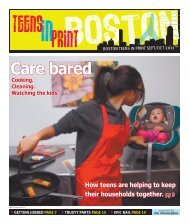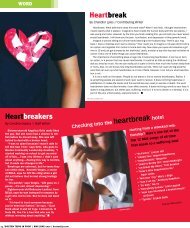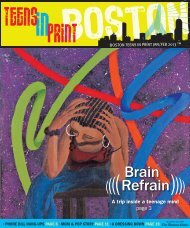BOSTON TEENS IN PRINT SEPT/OCT 2009
BOSTON TEENS IN PRINT SEPT/OCT 2009
BOSTON TEENS IN PRINT SEPT/OCT 2009
- No tags were found...
Create successful ePaper yourself
Turn your PDF publications into a flip-book with our unique Google optimized e-Paper software.
I know what you did last summer6 / <strong>BOSTON</strong> <strong>TEENS</strong> <strong>IN</strong> PR<strong>IN</strong>T / <strong>SEPT</strong>/<strong>OCT</strong> <strong>2009</strong> / www.bostontip.comFood for thoughtGreen teens spread the word about eating rightBy Akshat Pandey // Staff Writer7-Eleven, CVS, and McDonald’s:One of them is a conveniencestore, one is a pharmacy, andone is a fast food restaurant.But if you ask teens in Boston what thosethree places mean to them, you’ll get onecommon answer: food. For teens, conveniencehas become one of the biggest factorsin deciding where to eat their next meal.Common sense says that what’s cheapestisn’t always what’s best, but often, due tolack of funds, Boston youth will eat, for lackof a better word, junk.But despite the ignorance of the largerpopulation, some teens are beginning tolearn the physical benefits, and, yes, goodtaste, of eating healthy. At three Dorchesterlocations -- the ReVision Urban Farm, a singleacre spread across three lots; the FieldsCorner Farmer’s Market; and the CodmanSquare Farmer’s Market -- teens this summerwere found learning not only how togrow and sell fresh produce, but also how tobuild a healthy diet that will serve them fortheir whole lives.Nicole Blount, from Burke High School,and Ashley Shauna Deleon, from BostonLatin, are two 17-year-olds who workedat the Codman Square Farmer’s Market,where they reaped the benefits of eatingfreshly grown produce. “I’ve stopped goingto McDonald’s,” says Blount. “For a snack, Ihave my mom buy blueberries, and peaches,and other fruit.”The alternative to that is a lot of fat andcalories, making it a perfect recipe for heartdisease and diabetes, according to the U.S.Department of Health and Human Services.The Harvard School of Public Health reportsthat heart disease is the number one killerof men and women in the U.S.As a result of the giant “green” movement,a lot more research has beenrevealed. According to the PrincetonUniversity website, the lack of pesticides inorganic foods makes them both safer andmore nutritious to eat, while simultaneouslyhelping the environment.Now, teens are spreading the word aboutthe virtues of nutritional food. “It’s good foryou, and it’s good to not eat junk food all thetime,” says Treyvon Clegg, a 15-year-oldfrom Mattapan who worked at both theReVision Urban Farm and the Fields CornerFarmer’s Market.Clegg says he is trying to change theeating habits of a friend who doesn’t likefruits and vegetables. “I say, ‘You should eathealthy,’” says Clegg. “Of course junk food isgood, but it’s not good for you….Yeah, beforeI never used to eat vegetables, but nowI do. I’ve learned fresh vegetables tastegood, too.”But often, the problem with healthyfoods isn’t even their taste or price, buttheir general availability. In some neighborhoods,supermarkets -- let alone farmstands – are scarce. Clegg, who has oftenseen people choose the conveniencestore to shop, says, “There should bemore farms in the community, not justcorner stores.”While it’s impossible to keep people fromgoing to McDonald’s or Burger King, someteens say others should stop and thinkabout what they’re putting into their bodies.Deleon says that working at a farmer’s markethas opened her eyes to the food she’seating. “Now that I have this experience,I’m more open, and more wary, of fast foodchains,” she says. “Like sometimes, I’ll think,‘What does KFC or McDonald’s put intotheir stuff?’” ■▲ AFH photo by Darren HicksSummer T.i.P.sters down on the urban farm, learning about freshfruits and veggies.▲ AFH photo by Darren Hicks▲ AFH photo by Mary Nguyen


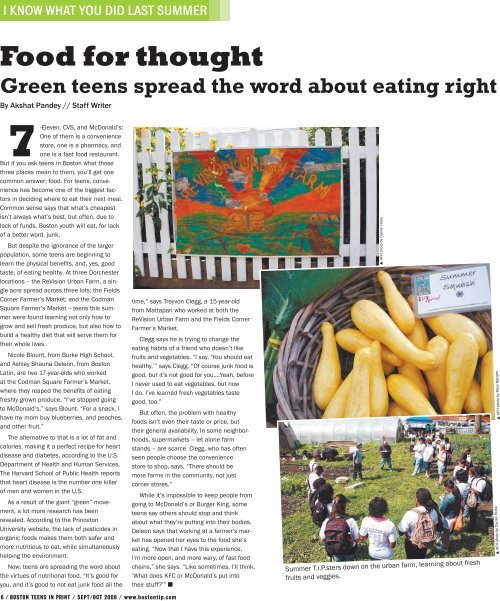
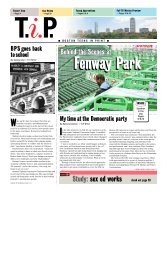

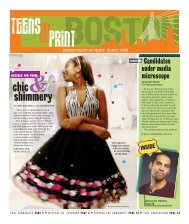
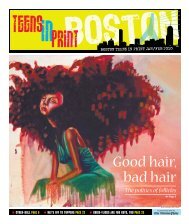
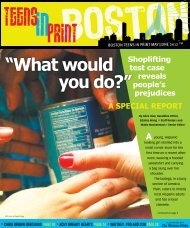


![=bWceh_p_d] j[[d fh[]dWdYo - Teens in Print](https://img.yumpu.com/42327830/1/190x229/bwceh-p-d-jd-fhdwdyo-teens-in-print.jpg?quality=85)

